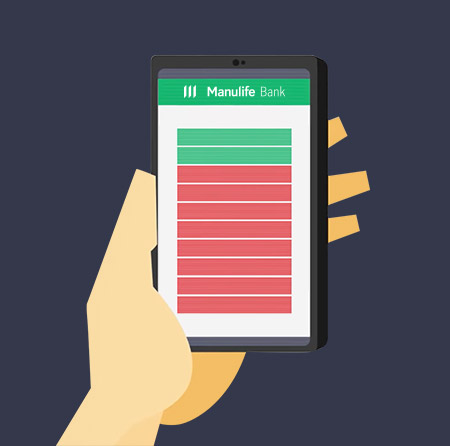Manulife One Discovery Centre
Customize your mortgage to fit your life
With Manulife One, you can create sub-accounts to customize your mortgage and manage your money your way. A sub-account is created when you section off a portion of your debt from the Main Account. The new account or sub-account is created within your Manulife One. There are two types of sub-accounts available—term and tracking—and they each offer their own distinct benefits.
Use term sub-accounts to add structure to your debt
With a term sub-account, you lock in a portion of your debt at a fixed rate for a specific period of time, such as five years – just like a traditional mortgage.
And just like a traditional mortgage, you make a principal and interest payment on the debt in the term sub-account at the end of each month. The payment is automatically taken from your Main Account.
Also like a traditional mortgage, term sub-accounts have limits on when you can make extra payments, and how much those payments can be. When the term is over, you can renew for another fixed term or you may be able to close the sub-account and move the remaining debt back into your Main Account.
Types of term sub-accounts and when to use them
When you open a Manulife One, you can borrow up to 80% of the appraised value of your home—debt up to 65% of the value of your home can go into the Main Account and anything above 65% is automatically locked into a non-readvancing term sub-account. Non-readvancing means that as you pay down that debt, you can’t reborrow it.
You can choose to set up additional term sub-accounts in your Manulife One if you’d like to lock in more of your debt at a fixed rate. And, for those term sub-accounts, you can choose whether they’re readvancing or non-readvancing. If you choose readvancing, the debt you repay in the sub-account automatically becomes available for you to reborrow from your Main Account.
- You are concerned about interest rates rising. The interest charged on the Main Account, called the Base Rate, is variable and can go up or down as rates change. You may want to lock in a portion of your debt if you expect interest rates to rise.
- You want to take advantage of low fixed rates. Sometimes fixed rates may be lower than the Base Rate and you want to “lock in” to take advantage of the lower rate on a portion of your debt.
- You want to be sure you’re paying down your debt over time. Setting up a term sub-account with its principal and interest payments will help add structure to your debt repayment and ensure you’re paying down the principal of your debt each month.
- You want to reduce the amount of credit you have access to in the Main Account. Some people may find a large line of credit difficult to manage. If this is true for you, you can lock in a portion of your debt in a non-readvancing term sub-account. As you pay down that debt, it does not become available for you to reborrow in the Main Account, reducing the amount of credit you have access to.
While there are several good reasons for setting up a term sub-account, keep in mind that you will give up some prepayment flexibility on this “locked in” portion of your debt. Unlike the Main Account, a term sub-account doesn’t allow you to make unlimited extra payments without paying a penalty. That’s why it’s generally best to keep a portion of your debt in the Main Account so you can take advantage of the unique payment flexibility it offers.
Your Main Account combines your mortgage, loans, savings, and income into one efficient account. This helps your money work harder and could save you interest. But what if you want to see the interest you’re paying on a specific amount of your debt? Easy—set up a tracking sub-account. With a tracking sub-account, you segment a portion of the debt in the Main Account so you can see the interest you’re paying on it.
Why would you want to track interest on a specific portion of your debt? Lots of reasons! Here are a few examples:
- Maybe you loaned money to a family member or friend
- Bought a new car
- Or, purchased an investment1
Tracking sub-account interest and payments
You’ll be charged the same variable interest rate on the tracking sub-account that you’re charged on the Main Account, but each month the balance and interest are reported separately.
And just like the Main Account, you can pay back your tracking sub-account as quickly or as slowly as you like. If you want to reduce the balance over time, like you would for a car loan, you can set up monthly payments from your Main Account. Or you can leave the balance at the original amount. This can be useful if you’re investing the money and plan to pay it back all at once when you sell the investment.1
See Term sub-accounts in action
See Tracking sub-accounts in action
You can customize your Manulife One account to fit your life by using two types of sub-accounts—term and tracking.
- Term sub-account: You lock in a portion of your debt at a fixed rate for a specific amount of time and make principal and interest payments on it—like a traditional mortgage.
- By locking in some of your debt, you could save money on interest costs, protect yourself from rising interest rates, help ensure you’re paying down your debt and reduce the amount of credit you have access to.
- But, because it’s “locked in”, you give up some prepayment flexibility on that portion of your debt. So don’t put all of your debt in a term sub-account, or you won’t be able to benefit from unique payment flexibility offered by the Main Account.
- Tracking sub-account: A tracking sub-account is an easy way to see the interest you’re paying on a portion of your debt. With a tracking sub-account, you pay the same rate of interest as the Main Account and can pay it off as slowly or as quickly as you like.
We invite you to talk to your advisor as part of your overall financial plan or your mortgage broker to find out more about Manulife One. If you don’t work with an advisor or broker, one of our mortgage specialists would be happy to help.
1Borrowing to invest may not be appropriate for everyone. You should be fully aware of the risks and benefits associated with leveraged borrowing since losses as well as gains may be magnified.
Manulife One is offered by Manulife Bank of Canada.
Manulife, Manulife Bank & Stylized M Design, ManulifeMONEY+, Stylized M Design and Manulife One are trademarks of The Manufacturers Life Insurance Company and are used by it, and by its affiliates under license.








